Drought and Suboptimal Habitats Shape Norway Spruce Vulnerability to Bark Beetle Outbreaks in Białowieża Forest, Poland
Abstract
1. Introduction
- Quantify changes in the share of spruce in the managed part of Białowieża Forest over more than a century using historical forest maps;
- Assess the distribution of spruce across habitats classified as suitable or unsuitable based on hydrological and edaphic characteristics;
- Analyse long-term climate records to identify hydro-climatic conditions associated with bark beetle outbreaks, including potential lag effects.
2. Materials and Methods
2.1. Study Area
2.2. Data Sources
2.3. Historical Data
2.4. Habitat Classification Data
- Suitable habitats for spruce: Sites where spruce is ecologically well adapted and typically occurs as a dominant species under natural conditions. This includes site types where spruce is also designated as a target species in the silvicultural objectives.
- Stands lacking spruce: These were stands which were suitable for spruce, but spruce did not dominate there.
- Unsuitable habitats for spruce: All other site types, including those where spruce is present but not ecologically optimal due to shallow or fluctuating water tables, poor drainage, or frequent drought stress. This group also includes mesic and dry broadleaved sites where spruce has been introduced through silviculture but is not a naturally dominant species.
2.5. Climate Data
2.6. Statistical Analysis
3. Results
3.1. Historical Trends in Spruce Dominance
3.2. Habitat Suitability and Spruce Distribution
3.3. Climatic Trends Relevant to Spruce Decline
3.4. Climate Conditions and Bark Beetle Outbreaks
4. Discussion
Mismatch Between Habitat and Spruce Presence
5. Conclusions
- A substantial share of spruce in the forest occurs in ecologically unsuitable habitats, making it inherently vulnerable to moisture deficits;
- Bark beetle outbreaks are strongly associated with multi-month drought indicators (negative SPEI-12, low Selyaninov k), confirming that hydro-climatic stress is a consistent outbreak trigger in this lowland temperate system;
- Drought in the year preceding an outbreak may act as a predisposing factor, amplifying the risk even under less extreme current-year conditions.
Author Contributions
Funding
Data Availability Statement
Acknowledgments
Conflicts of Interest
References
- Caudullo, G.; Tinner, W.; De Rigo, D. Picea Abies in Europe: Distribution, Habitat, Usage and Threats. Eur. Atlas For. Tree Species 2016, 114, 116. [Google Scholar]
- Kuuluvainen, T.; Gauthier, S. Young and Old Forest in the Boreal: Critical Stages of Ecosystem Dynamics and Management under Global Change. For. Ecosyst. 2018, 5, 26. [Google Scholar] [CrossRef]
- Vuidot, A.; Paillet, Y.; Archaux, F.; Gosselin, F. Influence of Tree Characteristics and Forest Management on Tree Microhabitats. Biol. Conserv. 2011, 144, 441–450. [Google Scholar] [CrossRef]
- Tanona, M.; Czarnota, P. Natural Disturbances of the Structure of Norway Spruce Forests in Europe and Their Impact on the Preservation of Epixylic Lichen Diversity: A Review. Ecol. Quest. 2019, 30, 7–17. [Google Scholar] [CrossRef]
- Augusto, L.; Ranger, J.; Binkley, D.; Rothe, A. Impact of Several Common Tree Species of European Temperate Forests on Soil Fertility. Ann. For. Sci. 2002, 59, 233–253. [Google Scholar] [CrossRef]
- Helmisaari, H.-S.; Derome, J.; Nöjd, P.; Kukkola, M. Fine Root Biomass in Relation to Site and Stand Characteristics in Norway Spruce and Scots Pine Stands. Tree Physiol. 2007, 27, 1493–1504. [Google Scholar] [CrossRef] [PubMed]
- Barber, V.A.; Juday, G.P.; Finney, B.P. Reduced Growth of Alaskan White Spruce in the Twentieth Century from Temperature-Induced Drought Stress. Nature 2000, 405, 668–673. [Google Scholar] [CrossRef]
- Moore, J. Wood Properties and Uses of Sitka Spruce in Britain; Research Report; Forestry Commission: Edinburgh, UK, 2011; ISBN 978-0-85538-825-6.
- Seidl, R.; Schelhaas, M.-J.; Lexer, M.J. Unraveling the Drivers of Intensifying Forest Disturbance Regimes in Europe. Glob. Change Biol. 2011, 17, 2842–2852. [Google Scholar] [CrossRef]
- Hlásny, T.; Krokene, P.; Liebhold, A.; Montagné-Huck, C.; Müller, J.; Qin, H.; Raffa, K.; Schelhaas, M.-J.; Seidl, R.; Svoboda, M.; et al. Living with Bark Beetles: Impacts, Outlook and Management Options; From Science to Policy; European Forest Institute: Joensuu, Finland, 2019. [Google Scholar]
- Sokołowski, A.W. Kierunki Naturalnej Sukcesji Zbiorowisk Lesnych Jako Podstawa Postepowania Hodowlanego w Lesnym Kompleksie Promocyjnym Puszcza Bialowieska. Pr. Inst. Badaw. Leśnictwa. Ser. B 1999, 36, 5–25. [Google Scholar]
- Bobiec, A. Białowieża Primeval Forest as a Remnant of Culturally Modified Ancient Forest. Eur. J. Forest Res. 2012, 131, 1269–1285. [Google Scholar] [CrossRef]
- Boczoń, A.; Kowalska, A.; Ksepko, M.; Sokołowski, K. Climate Warming and Drought in the Bialowieza Forest from 1950–2015 and Their Impact on the Dieback of Norway Spruce Stands. Water 2018, 10, 1502. [Google Scholar] [CrossRef]
- Bryk, M.; Kołodziej, B.; Pliszka, R. Changes of Norway Spruce Health in the Białowieża Forest (CE Europe) in 2013–2019 during a Bark Beetle Infestation, Studied with Landsat Imagery. Forests 2021, 12, 34. [Google Scholar] [CrossRef]
- Kamińska, A.; Lisiewicz, M.; Kraszewski, B.; Stereńczak, K. Comprehensive Analysis of Spruce Dieback between 2015 and 2019 in the Białowieża Forest. In The Current State of Białowieża Forest Based on the Results of the LIFE+ ForBioSensing Project; Instytut Badawczy Leśnictwa: Sekocin Stary, Poland, 2022; pp. 283–296. ISBN 978-83-62830-92-3. [Google Scholar]
- Das, A.K.; Baldo, M.; Dobor, L.; Seidl, R.; Rammer, W.; Modlinger, R.; Washaya, P.; Merganičová, K.; Hlásny, T. The Increasing Role of Drought as an Inciting Factor of Bark Beetle Outbreaks Can Cause Large-Scale Transformation of Central European Forests. Landsc. Ecol. 2025, 40, 108. [Google Scholar] [CrossRef] [PubMed]
- Georgievskij, A.B. Zakonomernost’ Processov Raspada i Vosstanovlenija v Korennykh Elovykh Lesakh Central’no-Lesnogo Zapovednika. In Problemy Izuchenija i Okhrany Zapovednykh Prirodnykh Kompleksov. Materialy Nauchn. Konf., Posvjashh. 60-Letiju Khoperskogo Zapov. (pos. Varvarino, Voronezhskaja obl., 21–25 Avgusta 1995 g.); Izd. Voronezhskogo Univ: Voronezh, Russia, 1995; p. 148. [Google Scholar]
- Gutowski, J.M. Problem ochrony ekosystemow lesnych a gradacja kornika drukarza. Przegląd Leśniczy 1996, 6, 18. [Google Scholar]
- Ermokhin, M.V. Postkatastroficheskaja dinamika el’nikov Belovezhskoj pushhi v ochagakh usykhanija. In Belovezhskaja Pushha na Rubezhe Tret’ego Tysjacheletija: Materialy Nauch.-Prakt. Konf., Posvjashh. 60-Letiju so Dnja Obrazovanija Gos. Zapov. “Belovezhskaja Pushha”; Kamenjuki, Brest. ObI.: Minsk, Belarus, 1999; p. 161. [Google Scholar]
- Jonášová, M.; Prach, K. Central-European Mountain Spruce (Picea abies (L.) Karst.) Forests: Regeneration of Tree Species after a Bark Beetle Outbreak. Ecol. Eng. 2004, 23, 15–27. [Google Scholar] [CrossRef]
- Pawlaczyk, P. Zbiorowiska Leśne. In Białowieski Park Narodowy. Poznać-Zrozumieć-Zachować; Okołów, C., Karaś, M., Bołbot, A., Eds.; Białowieski Park Narodowy: Białowieża, Poland, 2009; pp. 37–58. [Google Scholar]
- Kamińska, A.; Lisiewicz, M.; Kraszewski, B.; Stereńczak, K. Mass Outbreaks and Factors Related to the Spatial Dynamics of Spruce Bark Beetle (Ips typographus) Dieback Considering Diverse Management Regimes in the Białowieża Forest. For. Ecol. Manag. 2021, 498, 119530. [Google Scholar] [CrossRef]
- Netherer, S.; Lehmanski, L.; Bachlehner, A.; Rosner, S.; Savi, T.; Schmidt, A.; Huang, J.; Paiva, M.R.; Mateus, E.; Hartmann, H.; et al. Drought Increases Norway Spruce Susceptibility to the Eurasian Spruce Bark Beetle and Its Associated Fungi. New Phytol. 2024, 242, 1000–1017. [Google Scholar] [CrossRef]
- Jaroszewicz, B.; Cholewińska, O.; Gutowski, J.M.; Samojlik, T.; Zimny, M.; Latałowa, M. Białowieża Forest—A Relic of the High Naturalness of European Forests. Forests 2019, 10, 849. [Google Scholar] [CrossRef]
- Brzeziecki, B.; Keczyński, A.; Zajączkowski, J.; Drozdowski, S.; Gawron, L.; Buraczyk, W.; Bielak, K.; Szeligowski, H.; Dzwonkowski, M. Zagrożone gatunki drzew Białowieskiego Parku Narodowego (Rezerwat Ścisły). Sylwan 2012, 156, 252–261. [Google Scholar] [CrossRef]
- Dyderski, M.K.; Paź, S.; Frelich, L.E.; Jagodziński, A.M. How Much Does Climate Change Threaten European Forest Tree Species Distributions? Glob. Change Biol. 2018, 24, 1150–1163. [Google Scholar] [CrossRef]
- Dyderski, M.K.; Paź-Dyderska, S.; Jagodziński, A.M.; Puchałka, R. Shifts in Native Tree Species Distributions in Europe under Climate Change. J. Environ. Manag. 2025, 373, 123504. [Google Scholar] [CrossRef] [PubMed]
- Mareš, R. The Extent of Root Rot Damage in Norway Spruce Stands Established on Fertile Sites of Former Agricultural Land. J. For. Sci. 2010, 56, 1–6. [Google Scholar] [CrossRef]
- Mauer, O.; Palátová, E. Decline of Norway Spruce in the Krkonoše Mts. J. For. Sci. 2018, 56, 361–372. [Google Scholar] [CrossRef]
- Bengtsson, A.; Nilsson, C. Extreme Value Modelling of Storm Damage in Swedish Forests. Nat. Hazards Earth Syst. Sci. 2007, 7, 615. [Google Scholar] [CrossRef]
- Piri, T. Early Development of Root Rot in Young Norway Spruce Planted on Sites Infected by Heterobasidion in Southern Finland. Can. J. For. Res. 2011, 33, 604–611. [Google Scholar] [CrossRef]
- Seidl, R.; Schelhaas, M.-J.; Rammer, W.; Verkerk, P.J. Increasing Forest Disturbances in Europe and Their Impact on Carbon Storage. Nat. Clim. Change 2014, 4, 806–810. [Google Scholar] [CrossRef]
- Sowa, J.; Łakomy, P.; Brzeziecki, B.; Hilszczański, J.; Kowalski, T.; Miścicki, S.; Modrzyński, J.; Starzyk, J.R.; Małek, S. Opinia Rady Naukowej Leśnictwa Przy Prezesie Rady Ministrów RP w Sprawie Zamierania Drzewostanów Świerkowych Na Obszarze Nadleśnictw Białowieża, Browsk i Hajnówka Wchodzących w Skład Leśnego Kompleksu Promocyjnego “Puszcza Białowieska”; Polish Prime Minister’s Scientific Board for Forestry: Warsaw, Poland, 2016.
- Hlásny, T.; König, L.; Krokene, P.; Lindner, M.; Montagné-Huck, C.; Müller, J.; Qin, H.; Raffa, K.F.; Schelhaas, M.-J.; Svoboda, M. Bark Beetle Outbreaks in Europe: State of Knowledge and Ways Forward for Management. Curr. For. Rep. 2021, 7, 138–165. [Google Scholar] [CrossRef]
- Drozdowski, S.; Brzeziecki, B.; Żybura, H.; Żybura, B.; Gawron, L.; Buraczyk, W.; Zajączkowski, J.; Bolibok, L.; Szeligowski, H.; Bielak, K.; et al. Wieloletnia dynamika starodrzewów w zagospodarowanej części Puszczy Białowieskiej: Gatunki ekspansywne i ustępujące. Sylwan 2012, 156, 663–671. [Google Scholar] [CrossRef]
- Washaya, P.; Modlinger, R.; Tyšer, D.; Hlásny, T. Patterns and Impacts of an Unprecedented Outbreak of Bark Beetles in Central Europe: A Glimpse into the Future? For. Ecosyst. 2024, 11, 100243. [Google Scholar] [CrossRef]
- Šimůnek, V.; Vacek, Z.; Vacek, S.; Švanda, M.; Hájek, V.; D’Andrea, G. Norway Spruce Forest Management in the Czech Republic Is Linked to the Solar Cycle under Conditions of Climate Change—From Tree Rings to Salvage Harvesting. J. Space Weather Space Clim. 2024, 14, 37. [Google Scholar] [CrossRef]
- Nowakowska, J.A.; Łukaszewicz, J.; Borys, M.; Tereba, A.; Konecka, A.; Zawadzka, A.; Sułkowska, M.; Zajączkowski, P. Pochodzenie drzewostanów świerkowych (Picea abies L. Karst.) z Puszczy Białowieskiej na tle regionu RDLP Białystok na podstawie analiz mitochondrialnego DNA. Sylwan 2017, 161, 40–51. [Google Scholar] [CrossRef]
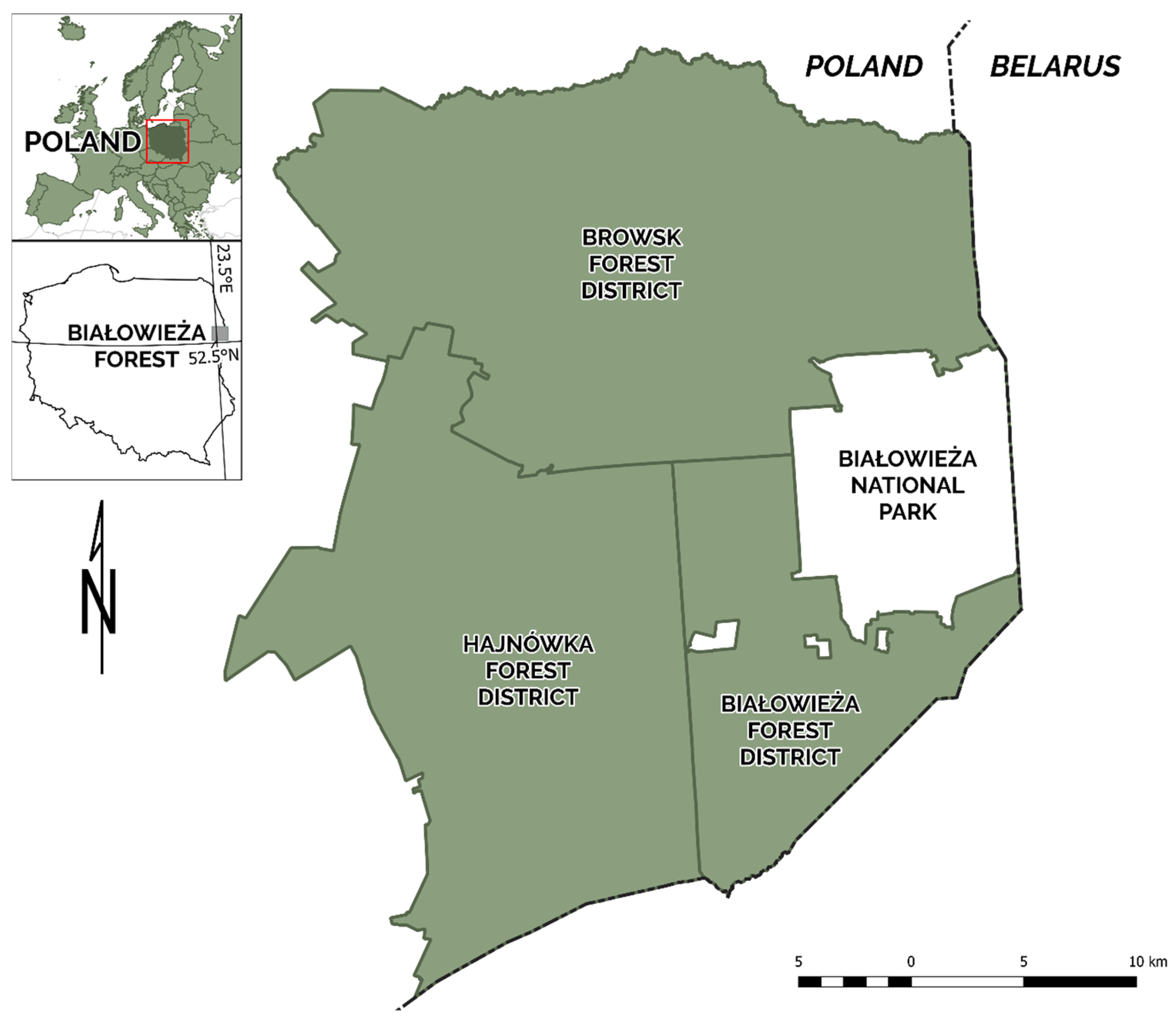
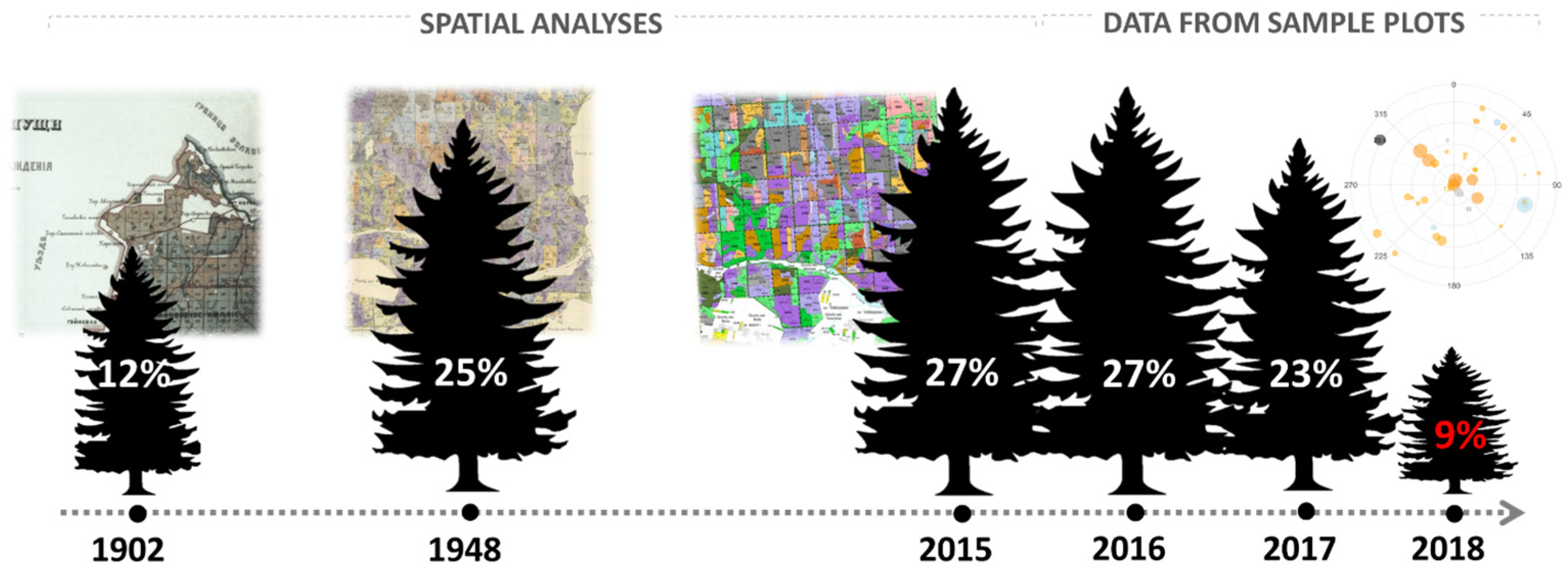
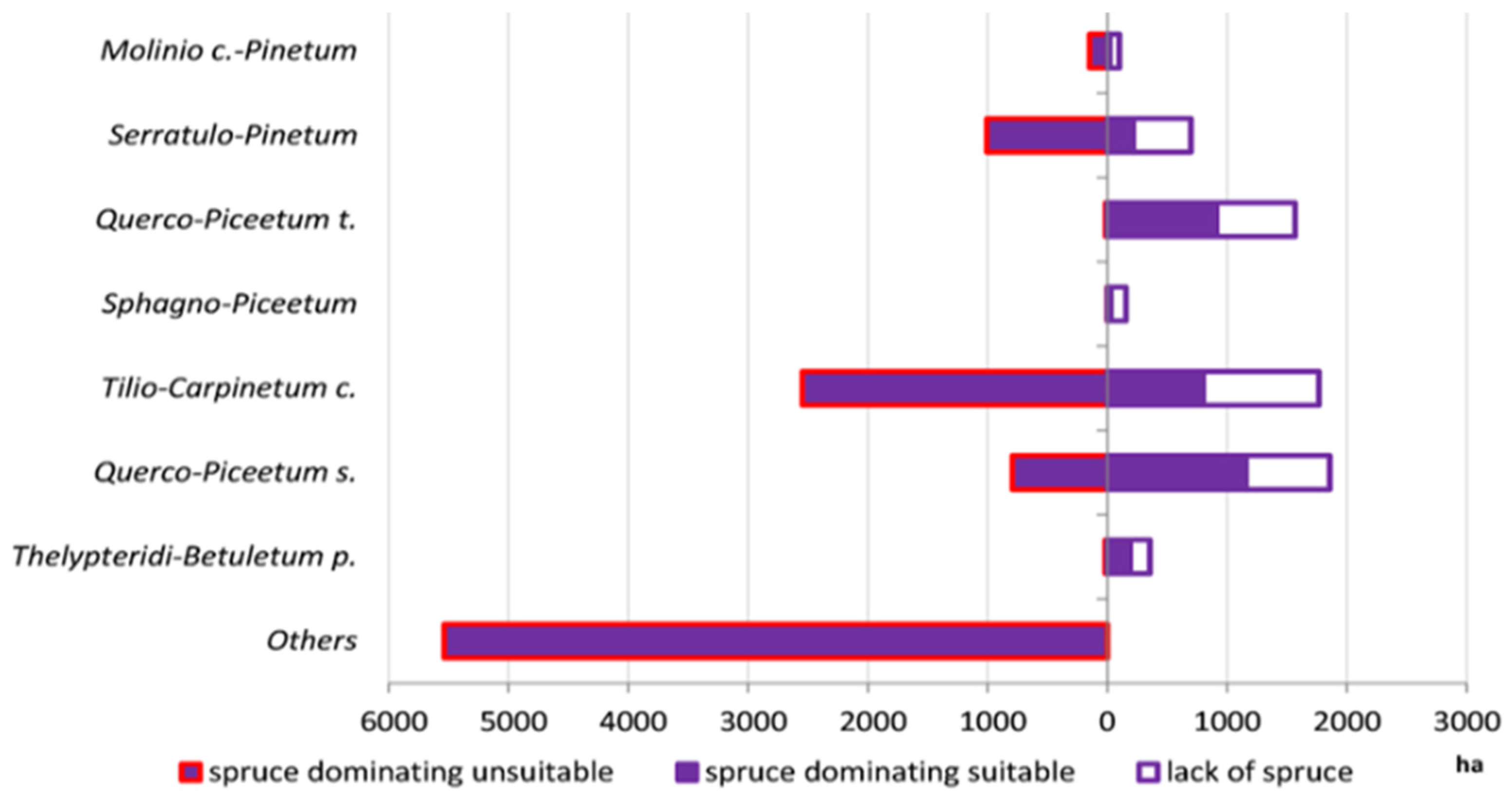
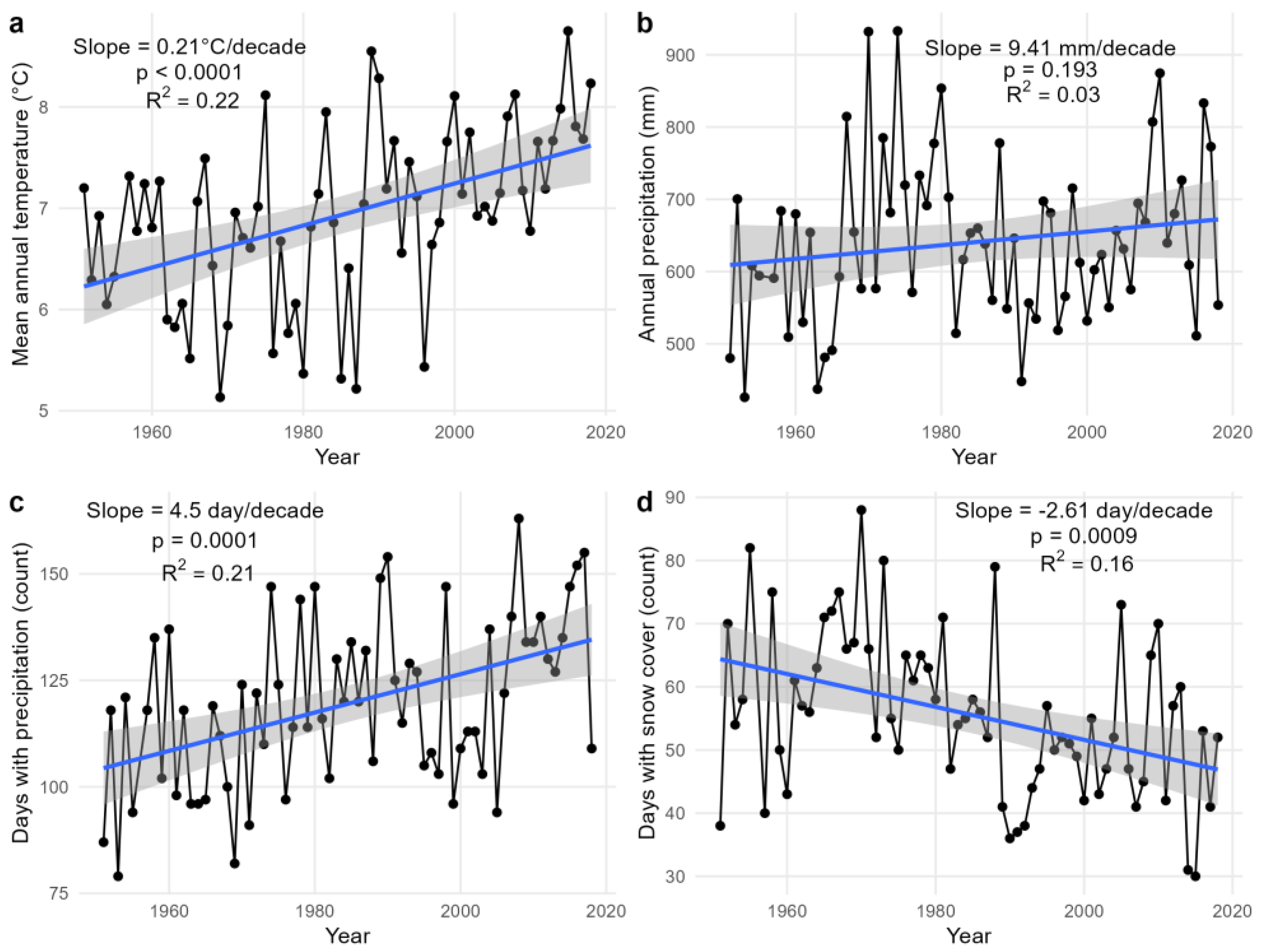
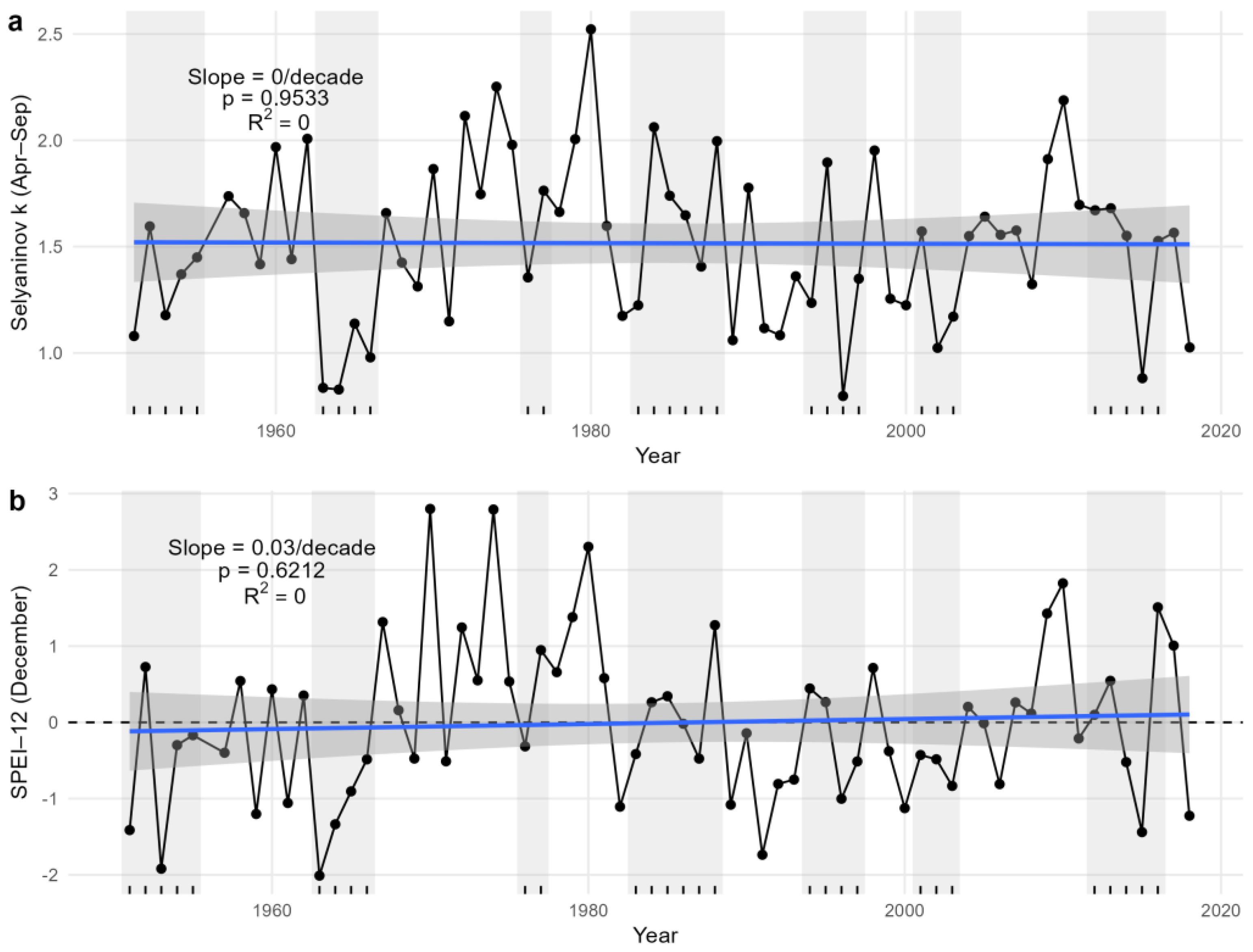
| Variable | Outbreak Mean | Non-Outbreak Mean | p-Value | pbc |
|---|---|---|---|---|
| Mean temp [°C] | 6.7 | 7.1 | 0.1719 | −0.17 |
| Total precip [mm] | 607.6 | 666.5 | 0.0317 * | −0.26 * |
| Days with rain | 114.6 | 123.6 | 0.0572 | −0.23 |
| Days with snow | 56.1 | 55.1 | 0.7664 | 0.04 |
| Selyaninov | 1.38 | 1.62 | 0.0087 * | −0.32 * |
| SPEI12 | −0.30 | 0.22 | 0.0407 * | −0.24 * |
| Variable | Outbreak Mean | Non-Outbreak Mean | p-Value | pbc |
|---|---|---|---|---|
| Mean temp [°C] | 6.8 | 7.0 | 0.5118 | −0.09 |
| Total precip [mm] | 591.7 | 679.7 | 0.0010 * | −0.38 * |
| Days with rain | 116.2 | 122.5 | 0.1844 | −0.16 |
| Days with snow | 52.2 | 58.1 | 0.0554 | −0.23 |
| Selyaninov | 1.40 | 1.61 | 0.0223 * | −0.28 * |
| SPEI12 | −0.45 | 0.35 | 0.0009 * | −0.38 * |
Disclaimer/Publisher’s Note: The statements, opinions and data contained in all publications are solely those of the individual author(s) and contributor(s) and not of MDPI and/or the editor(s). MDPI and/or the editor(s) disclaim responsibility for any injury to people or property resulting from any ideas, methods, instructions or products referred to in the content. |
© 2025 by the authors. Licensee MDPI, Basel, Switzerland. This article is an open access article distributed under the terms and conditions of the Creative Commons Attribution (CC BY) license (https://creativecommons.org/licenses/by/4.0/).
Share and Cite
Kędziora, W.; Szyc, K.; Silva, J.S.; Wójcik, R. Drought and Suboptimal Habitats Shape Norway Spruce Vulnerability to Bark Beetle Outbreaks in Białowieża Forest, Poland. Land 2025, 14, 2014. https://doi.org/10.3390/land14102014
Kędziora W, Szyc K, Silva JS, Wójcik R. Drought and Suboptimal Habitats Shape Norway Spruce Vulnerability to Bark Beetle Outbreaks in Białowieża Forest, Poland. Land. 2025; 14(10):2014. https://doi.org/10.3390/land14102014
Chicago/Turabian StyleKędziora, Wojciech, Katarzyna Szyc, Joaquim S. Silva, and Roman Wójcik. 2025. "Drought and Suboptimal Habitats Shape Norway Spruce Vulnerability to Bark Beetle Outbreaks in Białowieża Forest, Poland" Land 14, no. 10: 2014. https://doi.org/10.3390/land14102014
APA StyleKędziora, W., Szyc, K., Silva, J. S., & Wójcik, R. (2025). Drought and Suboptimal Habitats Shape Norway Spruce Vulnerability to Bark Beetle Outbreaks in Białowieża Forest, Poland. Land, 14(10), 2014. https://doi.org/10.3390/land14102014







